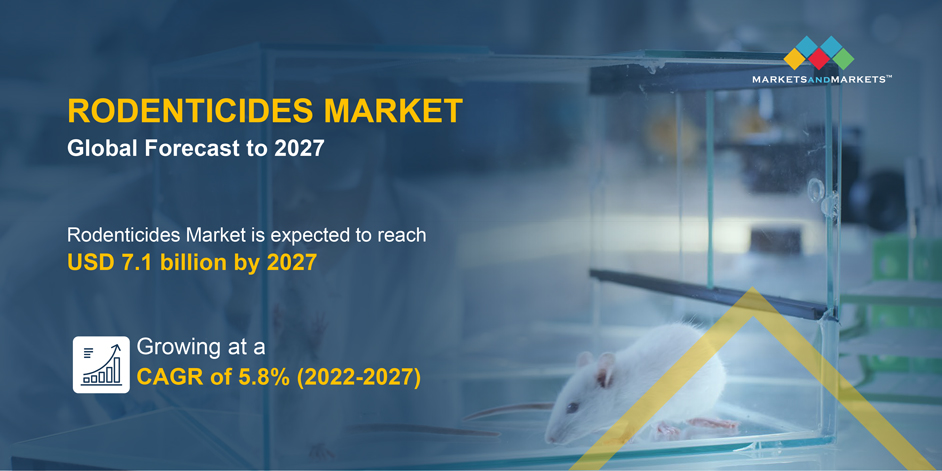MarketsandMarkets forecasts Rodenticides Market to grow from USD 4.7 billion in 2019 to USD 5.9 billion by 2025, at a Compound Annual Growth Rate (CAGR) of 3.7% during the forecast period. The major factors that are expected to be driving the rodenticides market are increasing rodent population and increasing damage due to rodent attacks alongside opportunities such as development of non-toxic and third-generation anticoagulants, increasing government initiatives for rodent control. The objective of the report is to define, describe, and forecast rodenticide market based on type, mode of Application, end-use Sector, and region.

Driver: Increasing damage due to rodent attack
Rodents can cause damage in various ways in the form of structural damage to buildings, building nests inside ducts, and gnawing of furniture in commercial and residential spaces. Moreover, all the crops grown for human and animal food are prone to damage by rodents. They destroy crops, particularly, cereals such as rice, wheat, barley, millet, corn, sorghum, legumes, and root crops such as cassava, taro, yams, and potatoes. Vegetable & fruit crops are also targeted by rodents.
As per an industry expert, rodents are the cause of around 33% of the overall crop losses every year. International Rice Research Institute (IRRI) also estimated that 1% of the overall cereal crops are damaged by rats across the globe, and in developing countries, the figure is around 3%-5%. According to the USDA, damages of USD 19 billion are incurred in the country from rodent attacks, annually. Rodents preferably attack and feed majorly on the embryo, resulting in damage to the seed’s germination ability and nutritional value. Apart from food losses, there are around 50 diseases such as typhoid, paratyphoid, and scabies that can be transmitted by rodents to humans. Moreover, rodents can act as vectors for a large number of diseases that can affect several domestic animals.
Download PDF Brochure: https://www.marketsandmarkets.com/pdfdownloadNew.asp?id=189089498
By type, the anticoagulant segment is expected to hold the largest market share during the forecast period
The rodenticides market has been segmented on the basis of types into non-anticoagulant and anticoagulant. The market for anticoagulant rodenticides is projected to record the highest market share between 2019 and 2025. Anticoagulant rodenticides are of lethal doses that kill rodents in a single dose or multiple doses. These rodenticides block the activity of the vitamin K cycle, resulting in the inability to produce blood clotting factors—prothrombin and proconvertin; this leads to internal bleeding and death of the animal. Anticoagulants act relatively slowly, when compared to the most acute rodenticides.
By mode of application, the pellets segment is expected to hold the largest market share during the forecast period
The rodenticides market has been segmented on the basis of mode of application into pellets, sprays, and powder. Pellets are the particles usually prepared by the compression of original materials. In terms of rodenticides, pellets are used with the baits for attracting the rodents. Rodenticides under pellets are available in various forms such as grains and wax blocks which makes it very easier to coat with any of the baits.
Speak to Analyst: https://www.marketsandmarkets.com/speaktoanalystNew.asp?id=189089498
North America is projected to dominate the rodenticides market by 2025.
The rodenticides market was dominated by North America in 2018 and is also projected to witness significant growth during the forecast period. This is due to the growing concerns of rodent attacks in the US. According to the Washington Post Company LLC (US), there were about 2 million New York City rats in 2014. According to Rentokil Initial Plc (UK), there are over 20,000 pest control service companies in North America; Orkin, Terminix, Rentokil, and Ecolab occupy a significant share in the market. Among all the pests, according to the same report, rodents were responsible for over 29% of pest incidents in America in 2017, 35% of which were from the North-Eastern region.
This report includes a study of the development strategies, along with the product portfolios of leading companies. It also includes the profiles of the companies in the rodenticide product market. These include BASF SE (Germany), Bayer (Germany), Syngenta (Switzerland), UPL (India), Liphatech Inc. (US), JT Eaton (US), Neogen Corporation (US), Pelgar International (UK), Senestech Inc. (US), Bell Laboratories (US), and Impex Europa (UK). The key players profiled under the rodenticide service market include Rentokil Initial Plc (UK), Terminix (US), Ecolab (US), Anticimex (Sweden), Rollins (US), Truly Nolen (US), and Abell Pest Control (Canada).
Recent Developments:
- In January 2019, Turner Pest Control, a Jacksonville-based Anticimex company acquired Brandon Pest Control (US). It is USD 8 million company that deals with pest control service provision. The acquisition is the part of company’s aggressive growth strategy.
- In April 2018, BASF (US) launched Selontra rodent bait, a soft bait formulation. This products is cholecalciferol based rodenticide which helps the professionals for rodent control.


